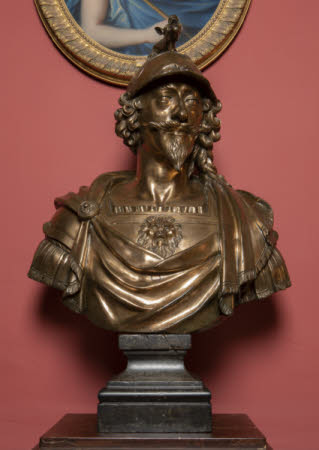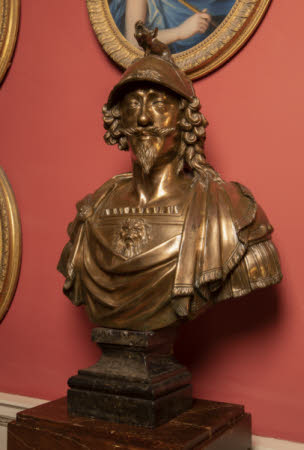Charles I (1600-1649)
Hubert Le Sueur (c.1580 - Paris 1658)
Category
Art / Sculpture
Date
circa 1636
Materials
Gilt bronze, stone
Measurements
680 x 620 x 300 mm
Place of origin
England
Order this imageCollection
Stourhead, Wiltshire
NT 731855
Caption
This gleaming gilt-bronze bust of Charles I (1600–49) by the French sculptor Hubert Le Sueur (c.1580–1658) shows him in the mid-1630s in an idealised style and was on view at the Palace of Whitehall in London during his reign. The fashionable style and craftsmanship would have impressed palace visitors, and they would also have noted his helmet topped with a dragon, an allusion to St George, England’s patron saint. Charles I was a lavish patron of artists and a lover of his own image. This was one of the many likenesses of himself or his family that he commissioned from some of the most talented and fashionable artists across Europe and that were displayed in his many palaces. After several years of bloody civil war, the authoritarian and quarrelsome king was deposed and executed in one of the most audacious acts in British history. This bust of the king was sold around 1650, but its value as a work of art was recognised, and it was preserved, possibly by royalist sympathisers, or by those who considered Charles a martyr. By the mid-18th century it was recorded at Stourhead in Wiltshire, where it is still displayed.
Summary
Gilt bronze sculpture on touchstone pedestal, King Charles I (1600-1649) by Hubert Le Sueur (c.1580 - London 1670), circa 1636. A gilt bronze bust of Charles I, wearing a helmet with a dragon cresting, cuirass and cloak, on moulded stone plinth. The artist, who was in England around 1624-42, made numerous busts and statues of the King including the celebrated equestrian figure in front of Trafalgar Square. This bust, originally gilded ('cast in brass' according to Abraham van der Doort in the Whitehall inventory) but darkened by varnish (and cleaned in 1978) is unique, being the only version with a helmet.
Full description
A skilled bronze founder, the French sculptor Hubert Le Sueur was brought to London in 1625 with the entourage of Henrietta Maria (1609-69), the bride of Charles I and daughter of Henri IV of France. In 1633 Le Sueur completed an armoured equestrian statue of the king which was famously hidden from Parliamentary forces before being placed in its current location, Trafalgar Square, after the Restoration. From this commission Le Sueur derived a series of portrait busts, starting with a prototype in marble signed and dated 1631, which is in the Victoria and Albert Museum (inv.no. A.35-1910). The Stourhead variant, cast in bronze and lustrously gilded, shows Charles I as a classical warrior and is unique among the series. It was owned by the king himself, originally set in a window erasure in the Chair Room of Whitehall Palace. Although it is not specifically listed in the records of Commonwealth sales (1649-51), the bust is clearly identified in Abraham van der Doort’s inventory of the king’s possession, circa 1638: ‘Done by the frenchman Lusheere...Y. owne Picture cast in brasse with a helmett upon his head whereon a dragon (after the Auncient Roman fasshion), And a scarfe about the shouldrs soe bigg as the life’. The frontal pose and veracity of detail show the influence of portrait busts of Charles’s father-in-law, Henri IV, by Mathieu Jacquet (c. 1546-c. 1611) and Barthélémy Tremblay (1578-1629). Jacquet’s helmeted image of the French king in the Salle des Gardes, Fontainebleau, has a sphinx as the helmet’s crest, replaced in the Stourhead version with a dragon alluding to the Caroline association with St George. The inverted triangle shape of the truncation, the swag of the classical drapery – not present in the Stourhead gilt bronze – and the decoration of the armour with its central mask, closely resemble the bronze portrait of Henri IV by Tremblay (1604) in the Musée Jacquemart-André, Paris. The helmet itself, and the lion’s mask on the breastplate, meanwhile, recall Le Sueur’s own figure of Mars mourning sculpted for the foot of the monument to George Villiers, 1st Duke of Buckingham, in Westminster Abbey (1634). Bronze variants and derivatives of the marble prototype conform to five general types. The earliest of these is a bust with lion-mask pauldrons given by Archbishop William Laud (1573-1645) to the Bodleian Library, Oxford, in around 1635. A derivative of this design, also with lion-mask pauldrons, is the bust said to have been presented by Charles I to Thomas, Earl of Stafford (Wentworth Woodhouse). The variant at Woburn Abbey (and Staatliche Kunstsammlungen, Dresden) has plain pauldrons. The fourth type, related to full-length bronze statues of Charles I at St John’s College, Oxford (1634) and Winchester Cathedral (1638), shows the king with an imperial crown, the Chain of the Order of the Garter, and an ermine cape. For centuries this bust was ensconced in a recess on the Market Cross at Chichester. A variant in bronze, without the crown and Chain, was incorporated into the wall monument to Sir Nicholas Crispe, an ardent Royalist, at St Paul’s Church, Hammersmith. Most likely an example of one of these types was the bronze bust ‘made and delivered by his Majesty’s command’ for the Square Tower at Portsmouth. Now lost, surviving accounts show that this image was paid for in June 1635. The fifth of Le Sueur’s designs is the present and unique gilt-bronze, which is first recorded at Stourhead by George Vertue in the early eighteenth century.
Provenance
Recorded in the Royal Collection inventory c. 1636-8 (Abraham van der Doort), in the Chair Room of Whitehall Palace; not clearly identified in records of the Commonwealth sales of the Royal Collection from 1649 onwards; acquired at an unknown date by Henry Hoare II (1705-85) at Stourhead where it remains; the house, collection and estate were given to the National Trust by Sir Henry Hugh Arthur Hoare, 6th Bt (1865–1947) in 1946.
Credit line
Stourhead, The Hoare Collection (National Trust)
Makers and roles
Hubert Le Sueur (c.1580 - Paris 1658), sculptor
Exhibition history
The Treasure Houses of Britain, National Gallery of Art, Washington, USA, 1985 - 1986, no.67
References
The Age of Charles I, Painting in England 1620-49, Tate Gallery, 15 November 1972 - 14 January 1973 Avery 1979 Charles Avery, 'Hubert le Sueur’s portraits of King Charles I in bronze, at Stourhead, Ickworth and elsewhere' National Trust Studies 147 (1979), pp.128-47 Avery 1980: Charles Avery, ‘Hubert Le Sueur, the “Unworthy Praxiteles” of King Charles I’, The Volume of the Walpole Society, vol. 48 (1980): 135-209, no. 33 The Treasure Houses of Britain: Five Hundred Years of Private Patronage and Art Collecting (exh cat) (ed. Gervase Jackson-Stops) National Gallery of Art, Washington, 2 November 1985 - 16 March 1986 Charles I, King and Collector, exh.cat., Royal Academy of Arts, London, 2018








